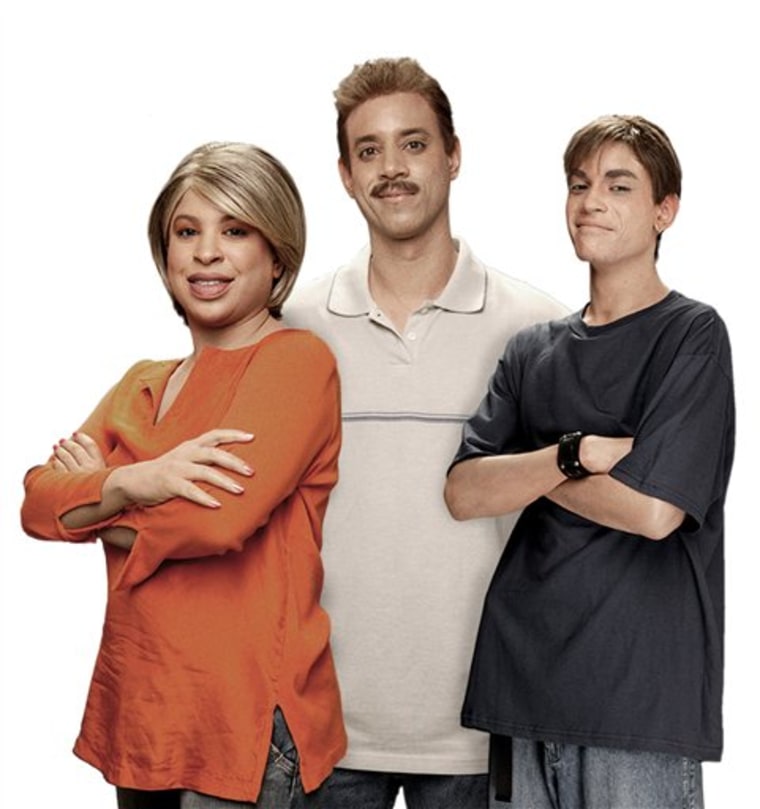When writer John Howard Griffin turned his skin from white to dark and traveled the South in 1959 for a firsthand look at the depths of racism, he relied on a simple medical treatment and his wits.
In the 21st century, such a journey requires Hollywood makeup wizardry, the well-honed conventions of both reality TV and documentary filmmaking, and two families, one black, one white, acting as undercover race detectives in Southern California.
As superficially different as FX’s “Black.White.” (premiering March 8, 10 p.m. ET) and Griffin’s landmark book “Black Like Me” appear to be, they are brothers under the skin.
“Black.White.” proceeds with open-minded seriousness as it leads viewers to a conclusion both obvious and powerful: race counts, for better and worse. Expressions of racism and racial identity change, but that bedrock truth remains.
“I didn’t realize, more than anything, how hard it was going to be for whites and blacks to see the world through each other’s eyes,” said executive producer R.J. Cutler. “I didn’t realize how genuinely different an experience it is to be a white American and a black American.”
Cutler insisted the six-episode show, which begins March 8 on FX, doesn’t “aspire in any way to say definitive things about race.” But the participants and their actions do.
The subtleties of racismIn a Los Angeles-area house, “Black.White.” brings together Bruno Marcotulli, 47, his wife, Carmen Wurgel, 48, and her daughter Rose Bloomfield, 18, a white family from Santa Monica, and Brian Sparks, 41, wife Renee, 38, and their son, Nick, 17, a black Atlanta family.
Through artful makeup they swap races, if not perspectives.

“You see what you want to see,” Marcotulli says at one point to Brian Sparks, dismissing Sparks’ experiences with prejudice.
“And you don’t see what you don’t want to see,” a frustrated Sparks replies.
Cutler, whose documentary films and TV series include the acclaimed “The War Room” and “American High,” was joined by Ice Cube, the rapper, actor and producer, on the project proposed by FX Networks President John Landgraf.
“Don’t believe the hype, everything in the world ain’t black and white. Everybody ain’t a stereotype. Just because I look wrong I’m about to do right,” Cube sings in the title song, which also includes his sharp rejection of an oft-cited phrase: “Did you get your race card? Yo, what the hell is a race card?”
His hope for the project was to “expose the subtleties of racism, the layers of racism,” the musician told The Associated Press. “Everybody thinks of a Klan man standing with a shotgun, yelling, ‘Keep it white.’
“Everybody is worried about the guy with the black power, leather jacket on, Afro ... worried about those kind of people and not really knowing that racism is not just the obvious,” Cube said.
The series’ timing is notable, with race brought into renewed focus by Katrina and the disproportionate suffering it caused for blacks in New Orleans. But “Black.White.” was conceived before the hurricane, Landgraf said.
Not ‘some kind of makeup-driven freak show’He brought the idea of having two families trade races to Cutler, stressing that he wasn’t looking for cheap conflict.
“I said, ‘This is not cheesy, this is not about putting a white bigot ... in with black people and watching them beat the crap out of each other and watching sparks fly,” Landgraf recalled. “And it certainly wasn’t about some kind of makeup-driven freak show.”
The families in “Black.White.” are middle-class, the adults all college-educated. They received a modest fee for their participation, an FX spokesman said.
With special-effects makeup by Keith Vanderlaan and Brian Sipe that artfully used wigs, airbrushed skin paint and other elements, the families were transformed to a new ethnicity that could pass muster in varied settings.
Teenager Rose joined a poetry group with young blacks; Brian Sparks became a bartender at a place drawing white customers. The families also, in the best tradition of reality TV, shared a house in 2005 for the six weeks of production.
Cutler “wanted the families to live together, because a lot of discussion would be generated in each family coaching the other family on what it is to be white or to be black, and to pass or behave or act as white or black,” Landgraf said.
Wurgel makes what she considers a black fashion statement, buying a dashiki for church, while Renee Sparks looks askance.
Revealing statements, clashesThe housemates have revealing, sometimes heated clashes over their attitudes on race and the use of volatile epithets. One confrontation pits the black father, adamantly opposed to the “n-word,” against his unconcerned teenage son.
For his part, Marcotulli consistently clings to his belief that any individual can erase bias by dint of sheer will and optimism.
Outside the house, attitudes are mostly, but not always, subtly expressed. In black makeup, Rose gets the brushoff when she applies for work at stores in a white area. One shopkeeper glances in a drawer and unconvincingly announces she’s out of job applications.
Sitting in as a white woman on a focus group discussion on race, Renee Sparks is shocked to hear a young college student relate how he was cautioned to wash off the handshake of a black person.
“I thought, here it is, 2005, and people are still teaching their kids this,” Sparks said in a recent interview with reporters.
Larry E. Davis, director of the University of Pittsburgh’s Center on Race and Social Problems, lauds the series’ concept. “Black Like Me” was a powerful work in its day; projects like “Black.White.” have potential value for now, he said.
“It will bring [issues of race] into a context and a time frame and a reality that a new generation can comprehend, can relate to and understand,” Davis said. The goal is to “keep hammering away, hammering way, hammering away at the problem.”